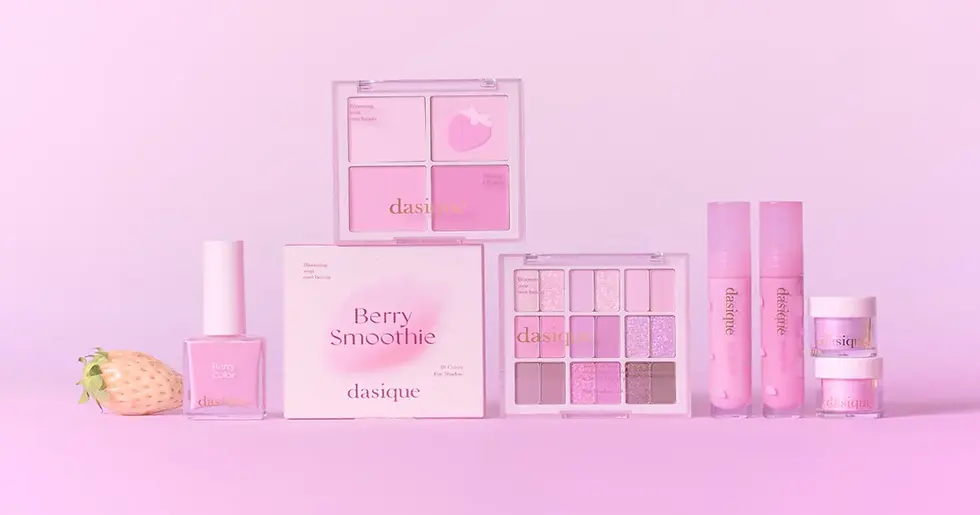East Asian Beauty Secrets: Chinese, Japanese, and Korean Makeup Unveiled
- Raquel Cruz
- 23 de jan.
- 4 min de leitura
The Art of Beauty: Key Differences Between Chinese, Japanese, and Korean Makeup
Asia has long been a global trendsetter in the beauty industry, with China, Japan, and Korea leading the charge. Each of these countries has a distinct approach to makeup, rooted in culture, history, and beauty ideals. Whether you’re drawn to the ethereal elegance of Japanese makeup, the radiant perfection of Korean beauty, or the sophisticated refinement of Chinese aesthetics, understanding their differences will deepen your appreciation for the artistry behind each style. Let’s dive into the key characteristics that set these three makeup styles apart.
Chinese Makeup: Elegance and Sophistication
Chinese makeup has experienced a modern revival while maintaining ties to its rich cultural history. Contemporary Chinese makeup is often characterized by a blend of natural elegance and sophisticated refinement, with trends influenced by both Western and traditional Chinese beauty ideals.
Key Features:
Flawless Matte Base:
Chinese makeup emphasizes a flawless, porcelain-like complexion with a matte or semi-matte finish. The goal is to create a look of effortless elegance and timeless beauty.
Defined Brows:
Brows are softly defined, with a natural arch that frames the face. Unlike Korean straight brows, Chinese brows tend to have a gentle curve for a more sophisticated look.
Focus on the Eyes:
Chinese eye makeup often incorporates neutral or earthy tones, with subtle shimmers or gradients. Winged eyeliner is common but kept minimal to enhance the eyes without overpowering them.
Sophisticated Lips:
Gradient lips are less common; instead, bold yet refined lip colors like deep reds, berries, or soft peaches are favored. These colors evoke a sense of confidence and maturity.
Cultural Influence:
Chinese beauty trends often draw inspiration from historical aesthetics, such as the Tang Dynasty’s rosy cheeks and bold lips, while modern influencers add a cosmopolitan twist.

Japanese Makeup: Minimalism Meets Soft Glam
Japanese makeup celebrates natural beauty, emphasizing subtle enhancements and a youthful, innocent glow. The focus is on creating harmony and balance, reflecting the country’s broader cultural appreciation for simplicity and refinement.
Key Features:
Natural, Dewy Skin:
Japanese makeup highlights healthy, hydrated skin with a dewy finish. The use of lightweight foundations, tinted moisturizers, and illuminating primers is common.
Straight, Soft Brows:
Eyebrows are natural-looking and straight, often lighter in color to match hair tones. The goal is to create a soft, approachable appearance.
Subtle Eyeshadow and Eyeliner:
Japanese eye makeup leans toward soft pastels, champagne tones, and neutral hues. Eyeliner is applied sparingly, often to the upper lash line, to subtly define the eyes.
Blush as a Statement:
Blush placement is key in Japanese makeup. Often applied high on the cheeks or across the nose bridge, it gives a youthful, “flushed” appearance.
Natural Lips:
Lip makeup is typically understated, with soft pinks, corals, or sheer tints that enhance natural lip color without being too bold.
Cultural Influence:
The concept of “Wabi-Sabi,” or finding beauty in imperfection, heavily influences Japanese makeup. The result is a look that feels effortless yet meticulously crafted.

Korean Makeup: The Pursuit of Radiance
Korean makeup, synonymous with the globally popular K-beauty movement, is all about achieving a youthful, radiant look. It prioritizes innovation, with trends often dictated by the latest beauty technologies and products.
Key Features:
Glass Skin:
Korean makeup starts with skincare. The hallmark of K-beauty is “glass skin”—a translucent, glowing complexion achieved through layers of hydrating skincare and lightweight, luminous foundations.
Straight Brows:
Korean eyebrows are straight and softly filled, creating a youthful, innocent appearance that complements the overall look.
Gradient Eyeshadow:
Soft, gradient eyeshadows in peach, pink, or coral tones are popular. The focus is on enhancing the eyes subtly rather than creating dramatic effects.
Puppy Eyeliner:
Unlike the upward wing of Western eyeliner, Korean eyeliner often follows the natural curve of the lower lash line, creating a “puppy eye” effect for a rounder, more youthful look.
Gradient Lips:
Gradient lips are a quintessential K-beauty trend. A softer, faded look is achieved by concentrating color at the center of the lips and blending outward, creating a fresh and youthful vibe.
Cultural Influence:
Korean beauty places a strong emphasis on skincare and youthful aesthetics. The “chok chok” (dewy) look reflects Korea’s cultural ideal of healthy, hydrated skin.

Comparing the Styles
Feature | Chinese Makeup | Japanese Makeup | Korean Makeup |
Skin Finish | Matte or semi-matte | Natural and dewy | Luminous, “glass skin” |
Brows | Softly arched | Straight and natural | Straight and youthful |
Eyeshadow | Neutral tones, subtle gradients | Soft pastels and neutral shades | Gradient with warm tones |
Eyeliner | Minimal, defined wing | Thin and subtle | Puppy-style for rounder eyes |
Blush | Light and natural | Flushed, across cheeks and nose | Minimal or soft coral tones |
Lips | Bold and refined | Sheer pinks or corals | Gradient, soft and youthful |
Celebrating Diversity in Beauty
The beauty of Chinese, Japanese, and Korean makeup lies in their individuality. Each style offers unique approaches to enhancing natural beauty, influenced by cultural values and aesthetics. Whether you’re drawn to the sophisticated elegance of Chinese makeup, the minimalist charm of Japanese beauty, or the radiant glow of Korean trends, these styles provide endless inspiration.
For brands and beauty enthusiasts, exploring these differences offers opportunities to celebrate diversity and connect with audiences worldwide. Which style resonates most with you? Share your thoughts below, and let’s continue the conversation about the artistry of Asian beauty!



Comentários